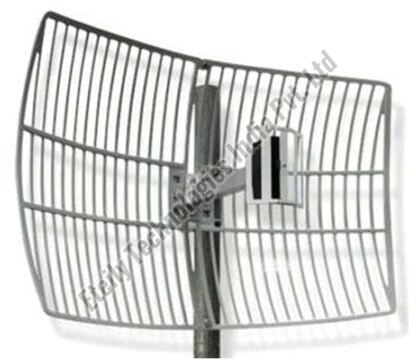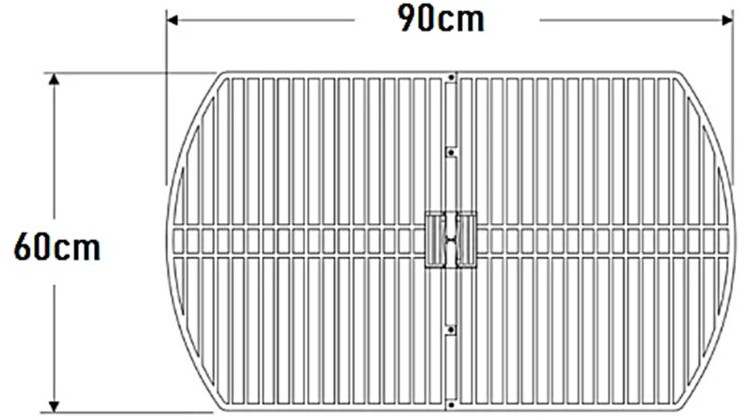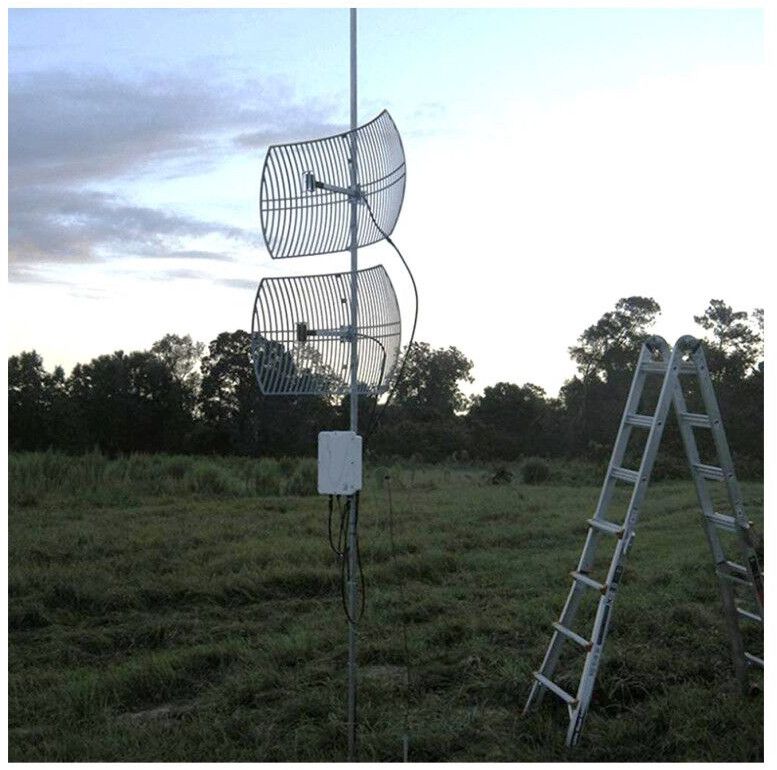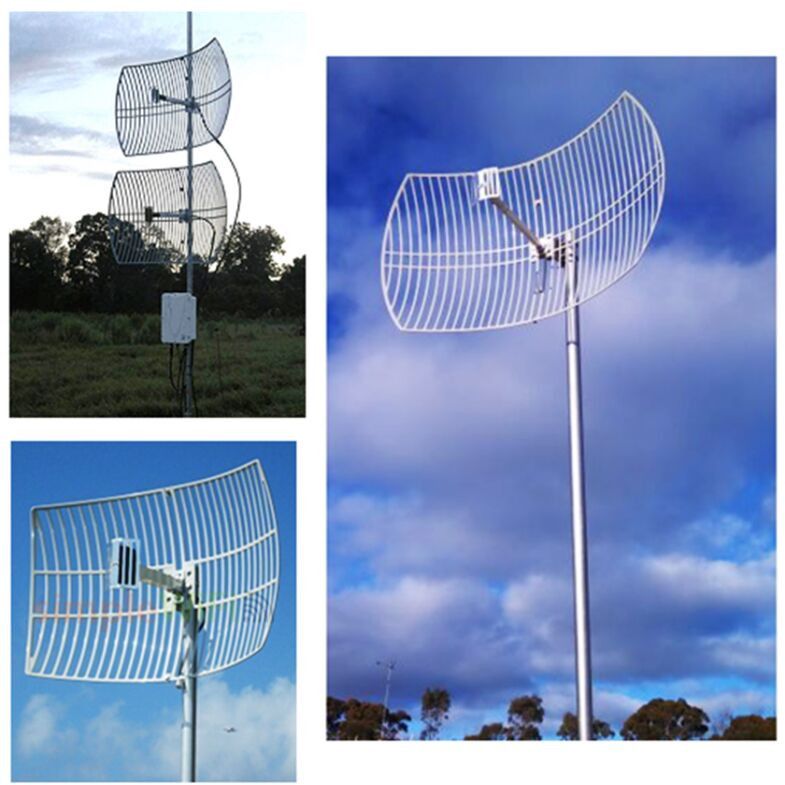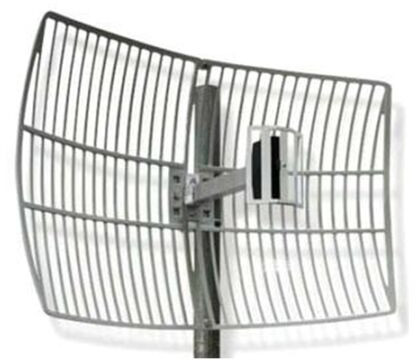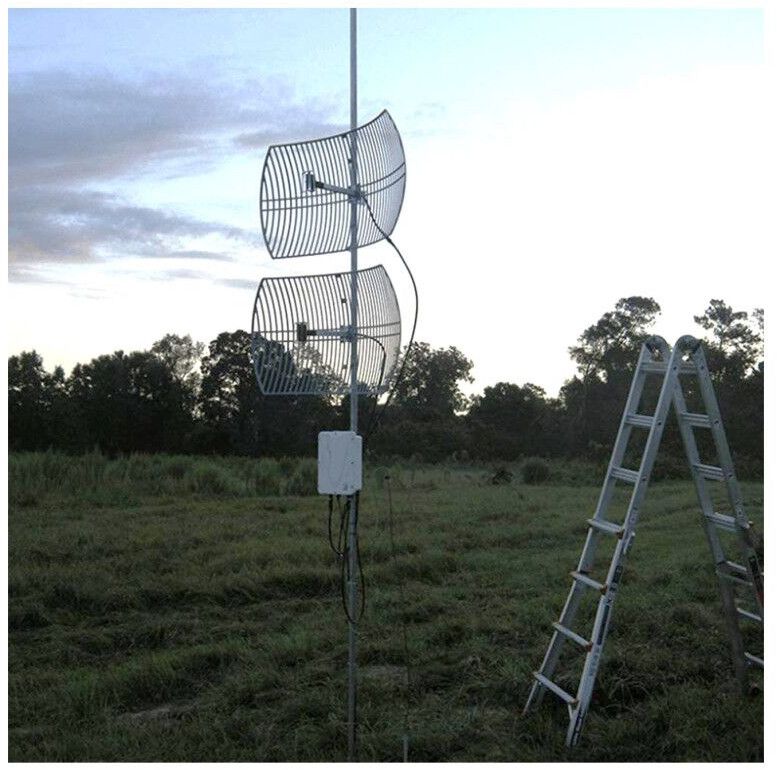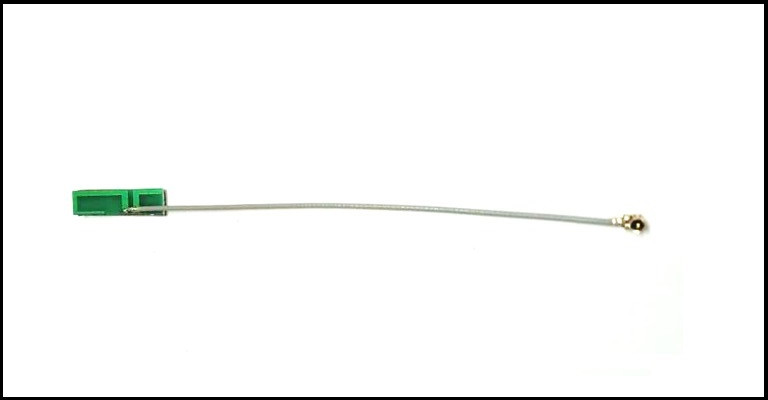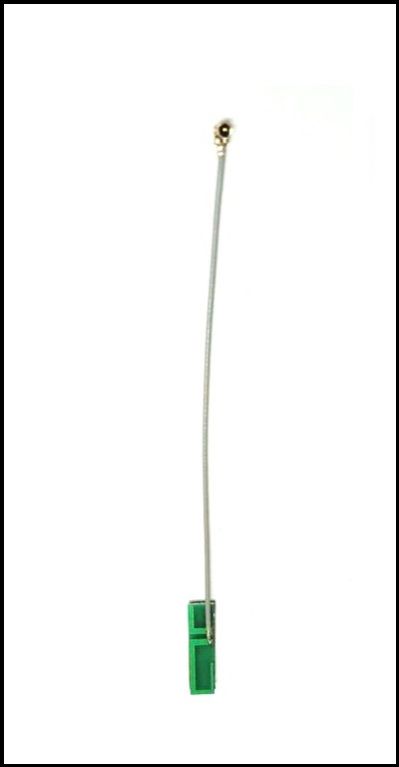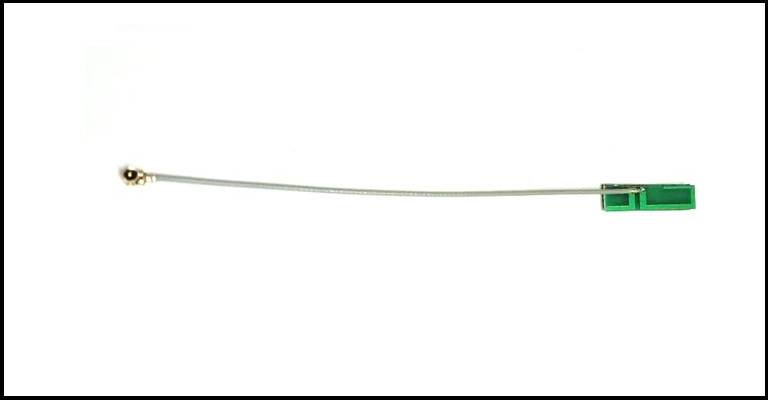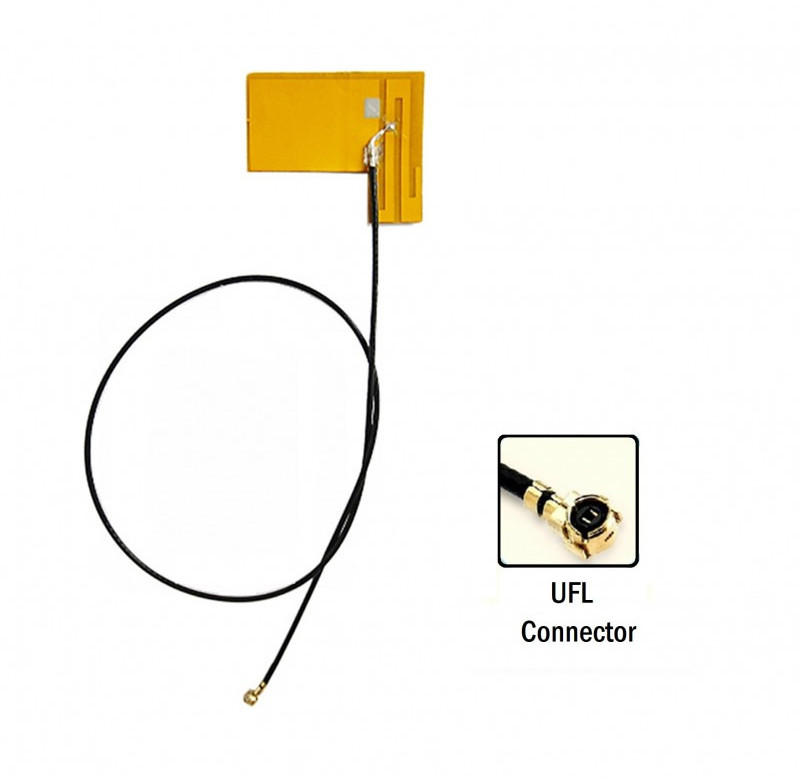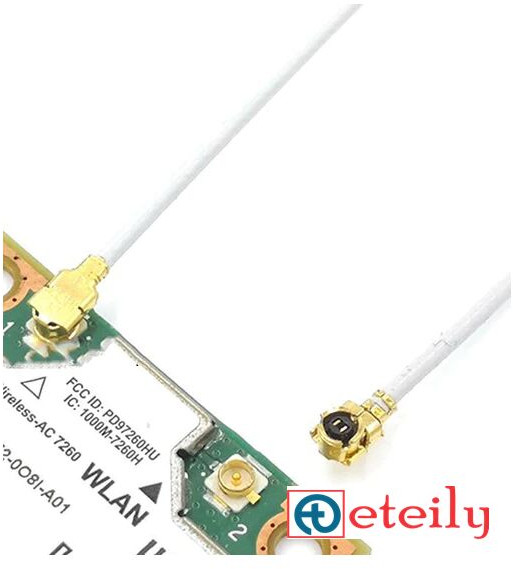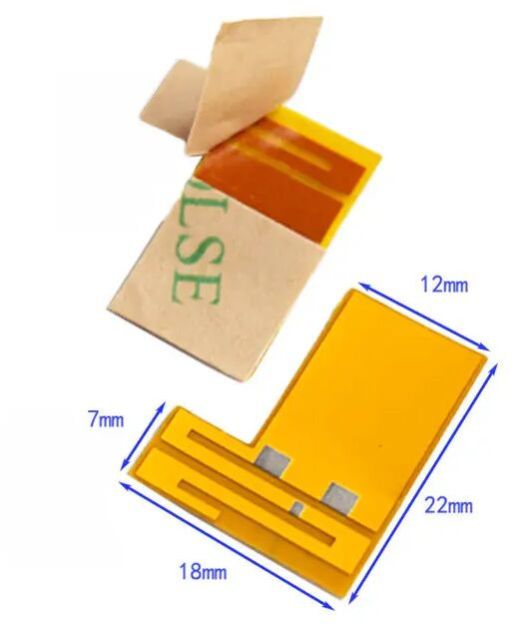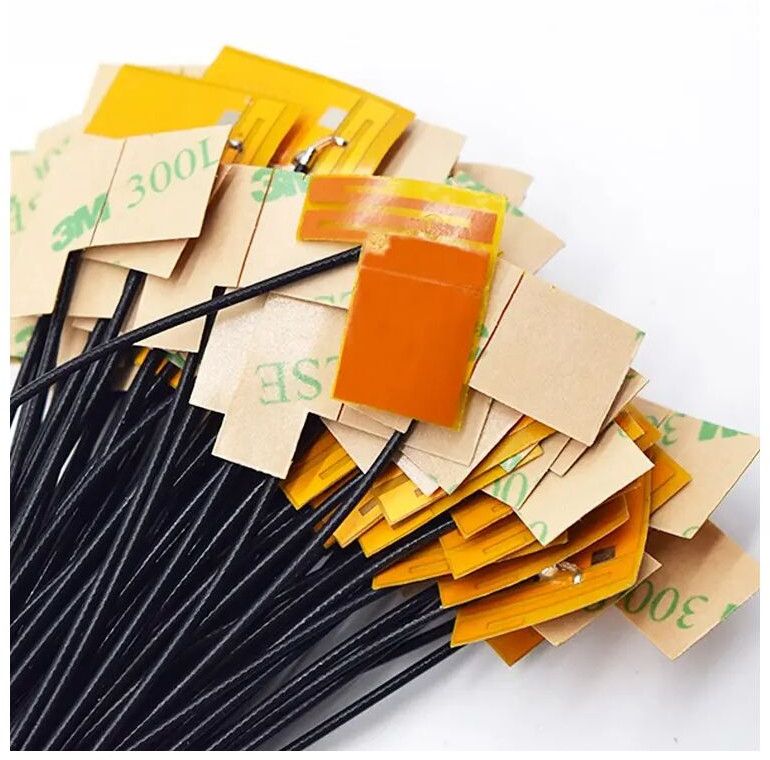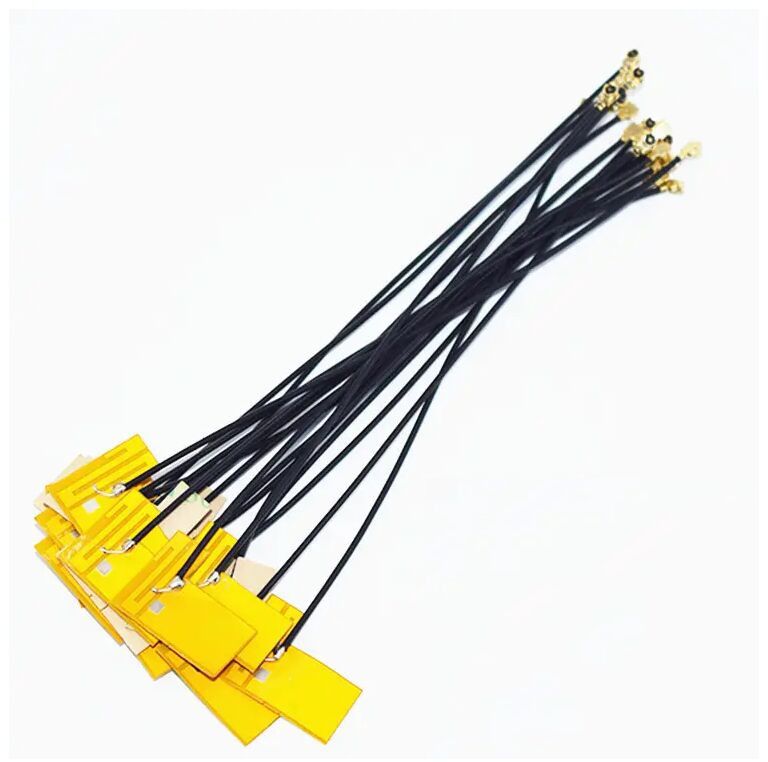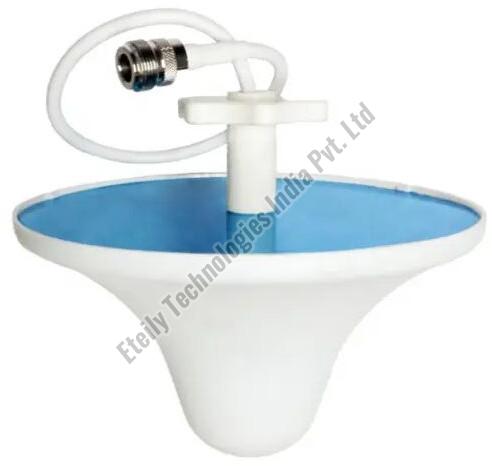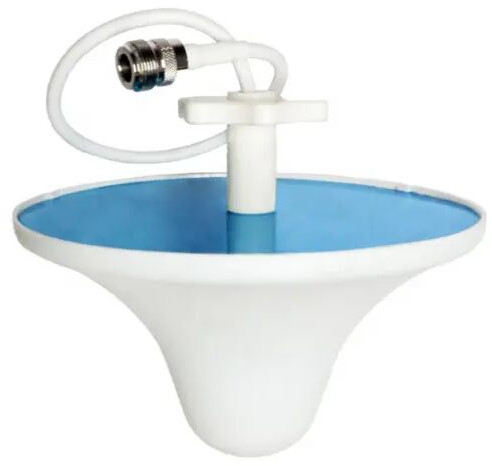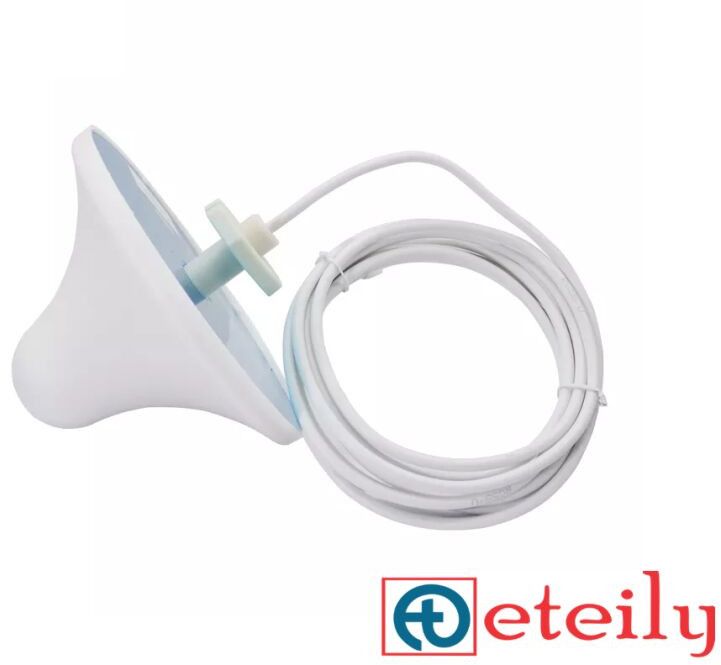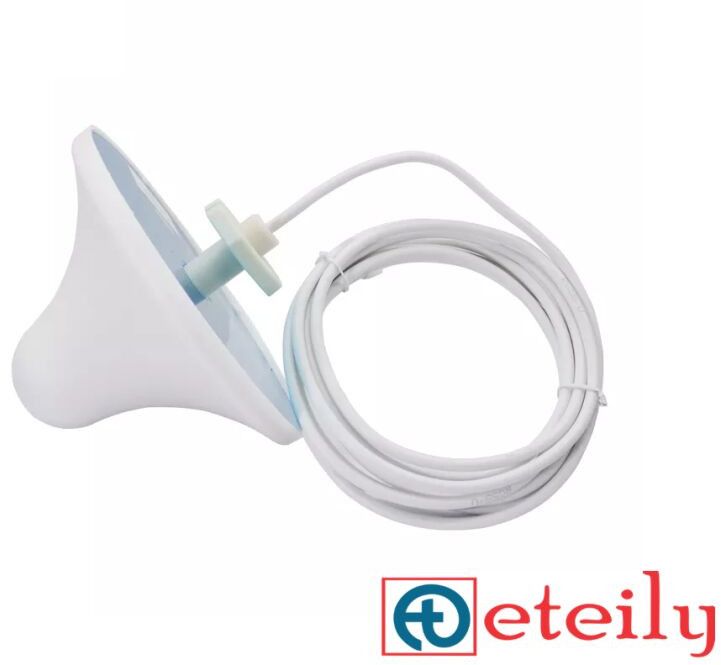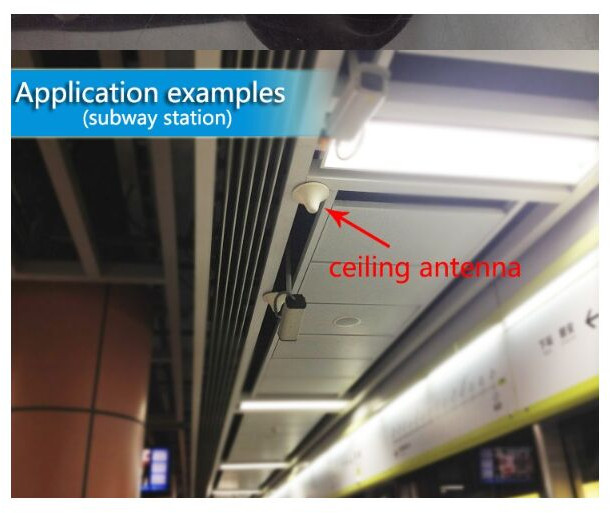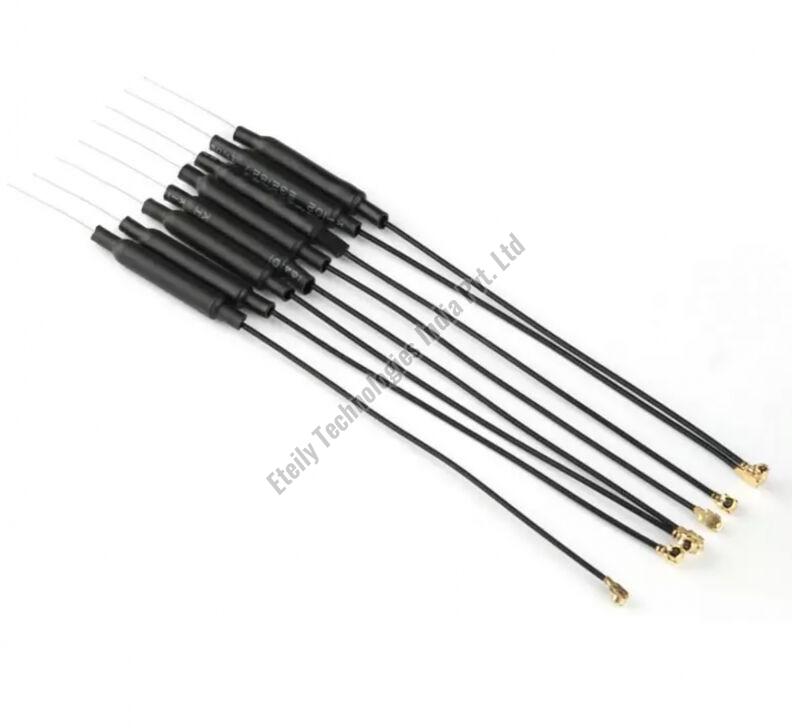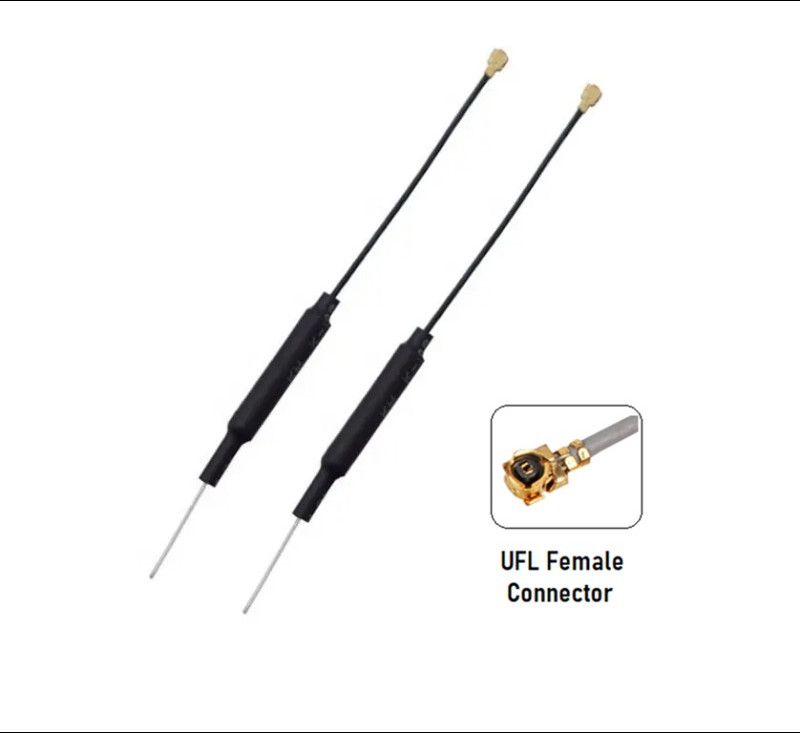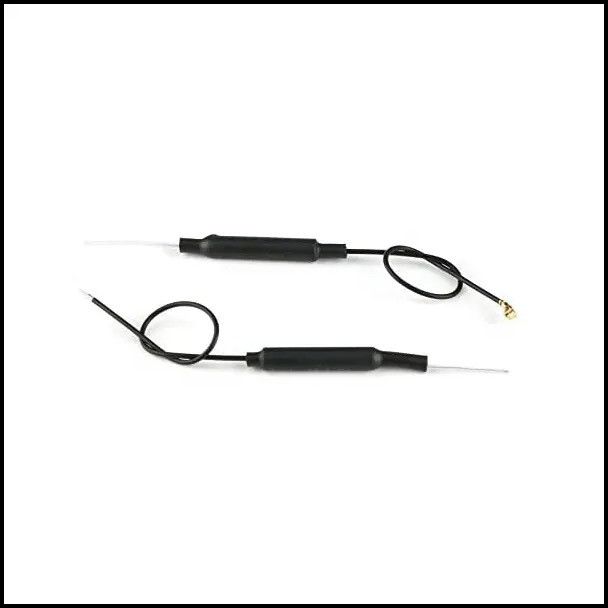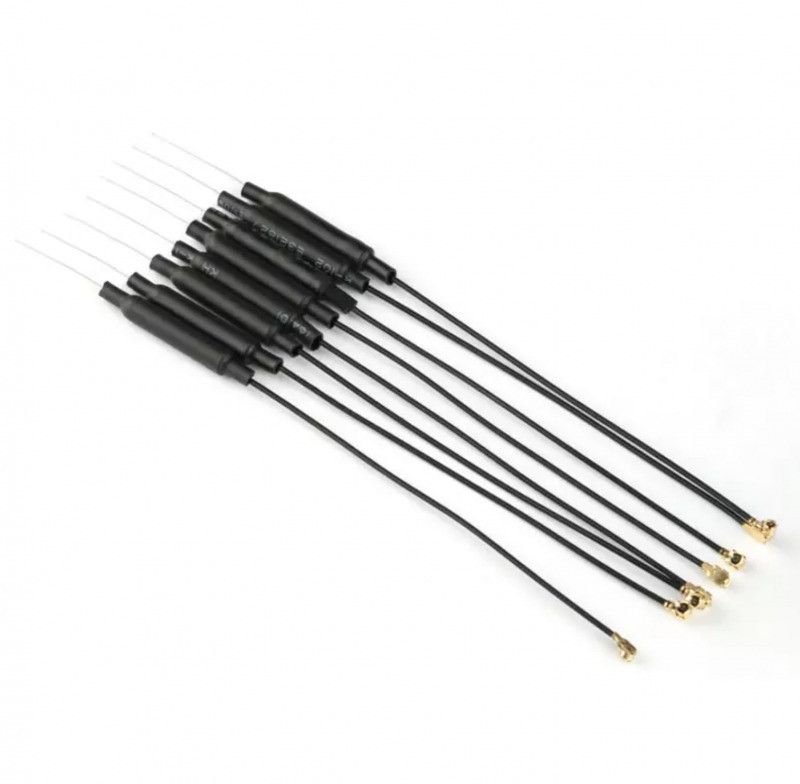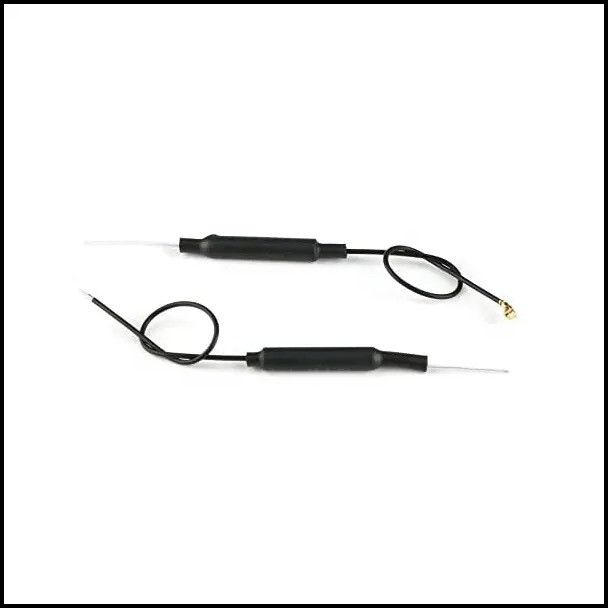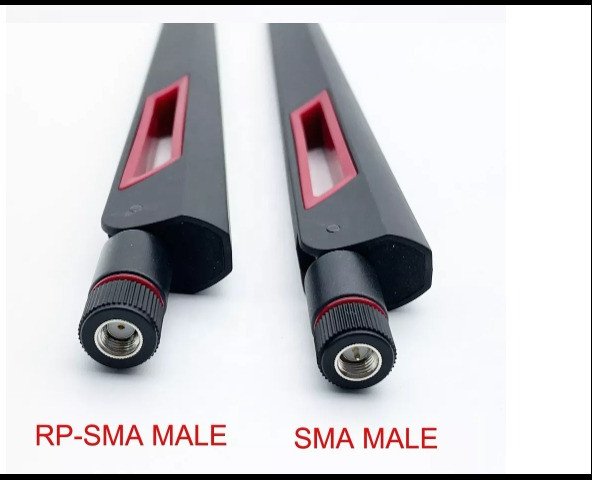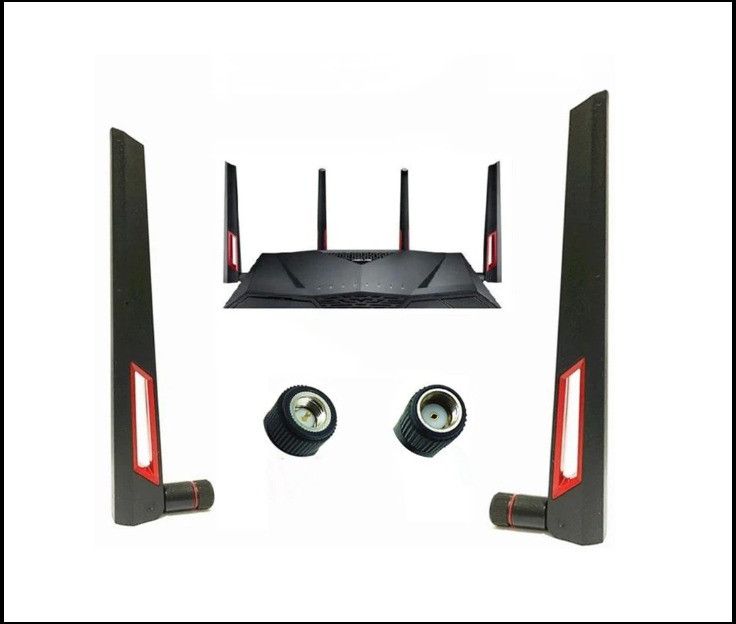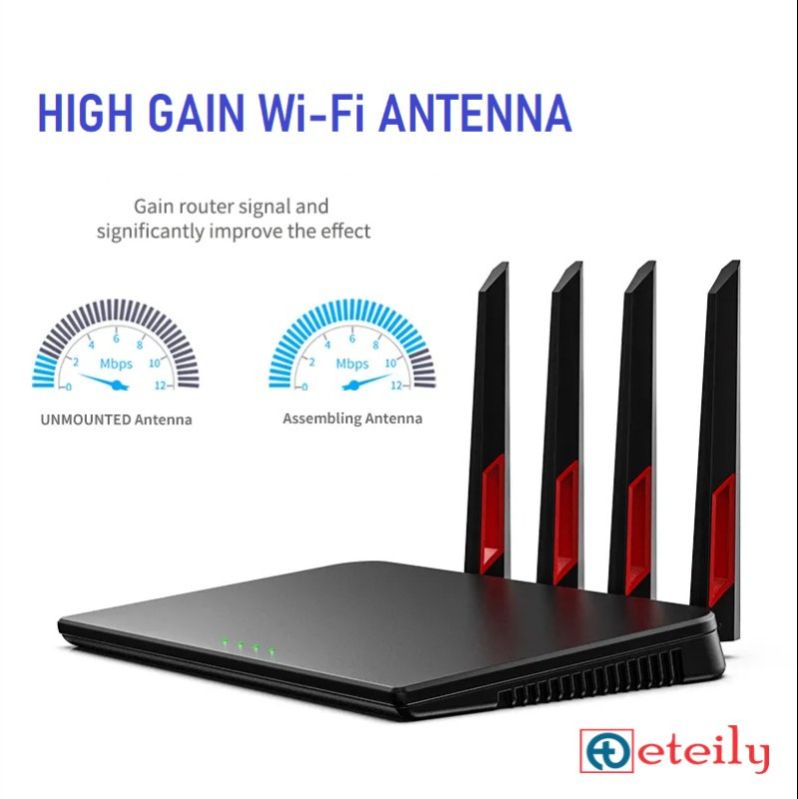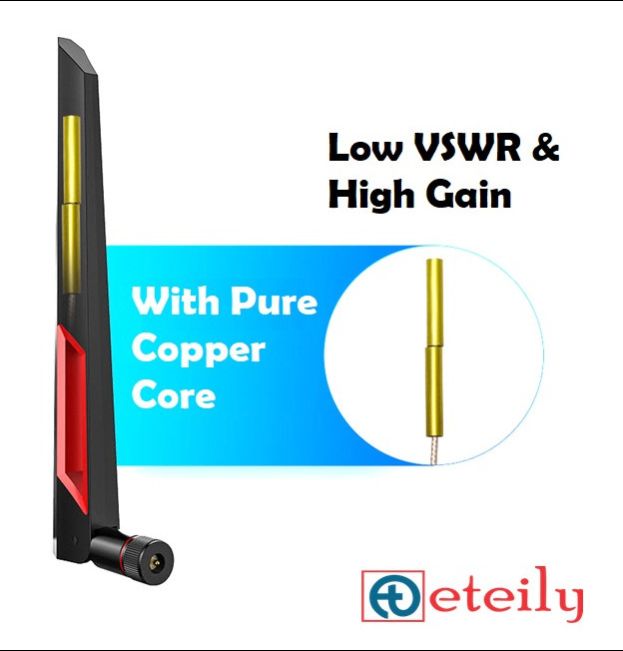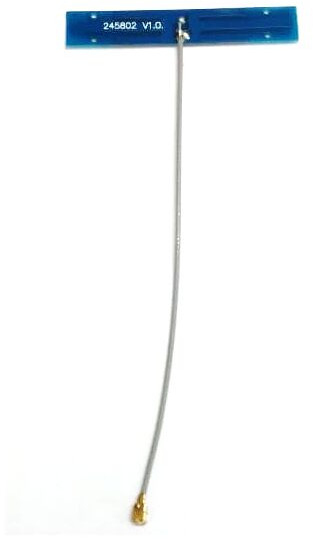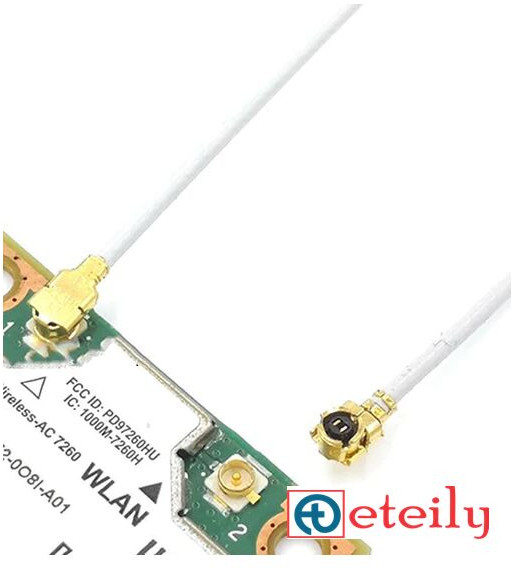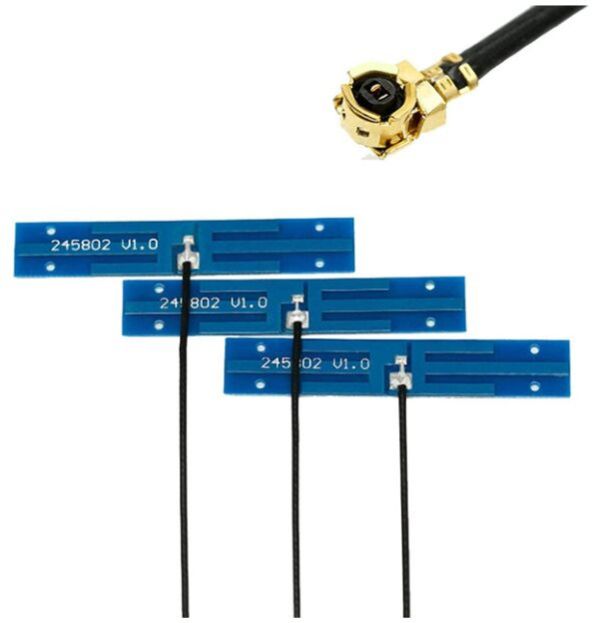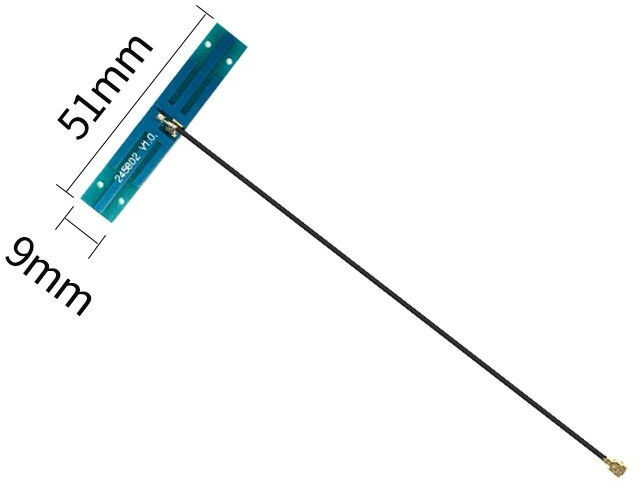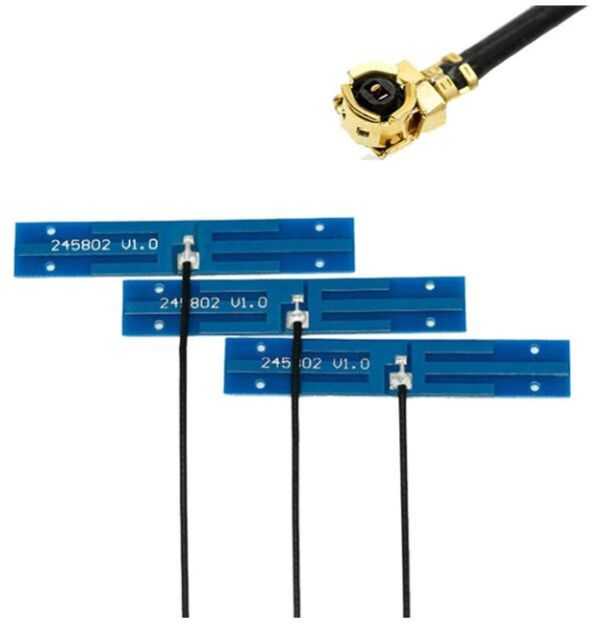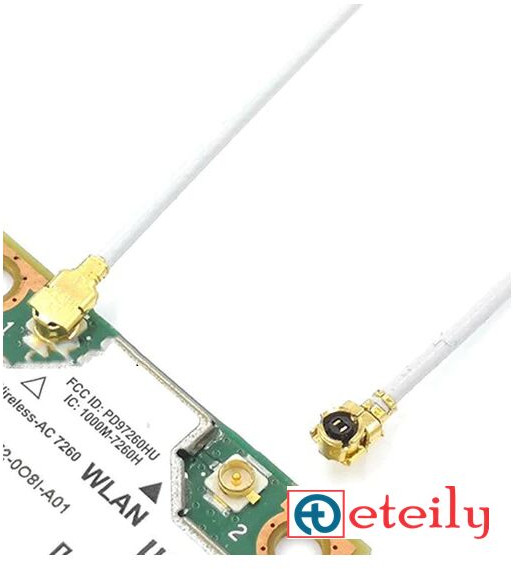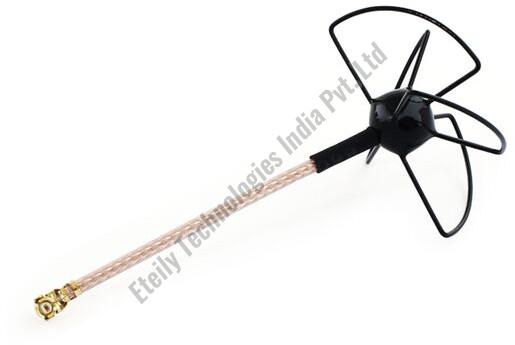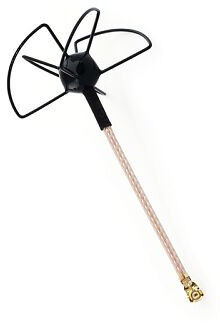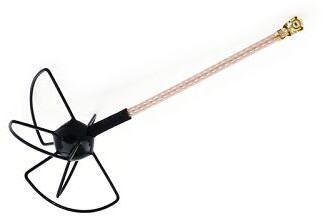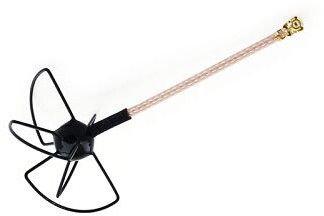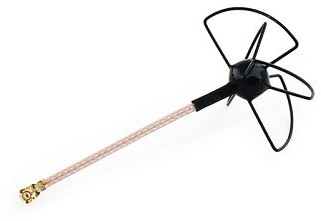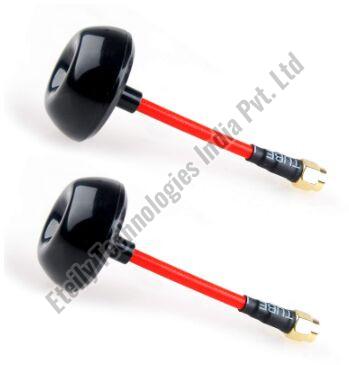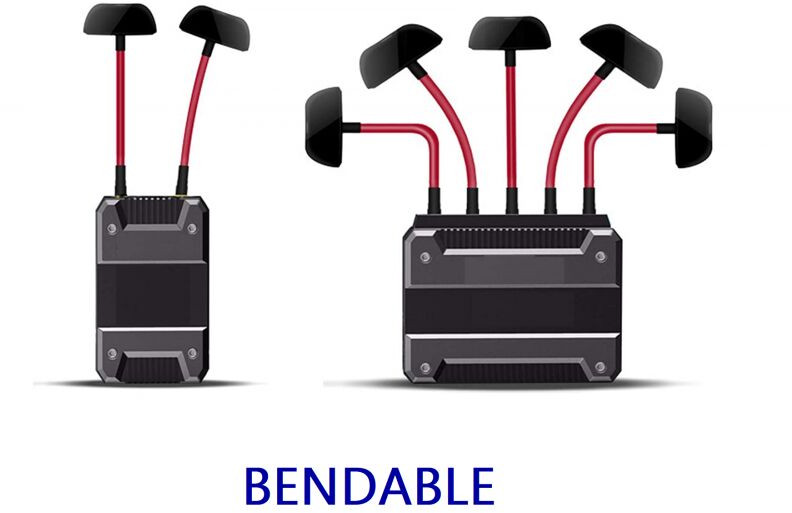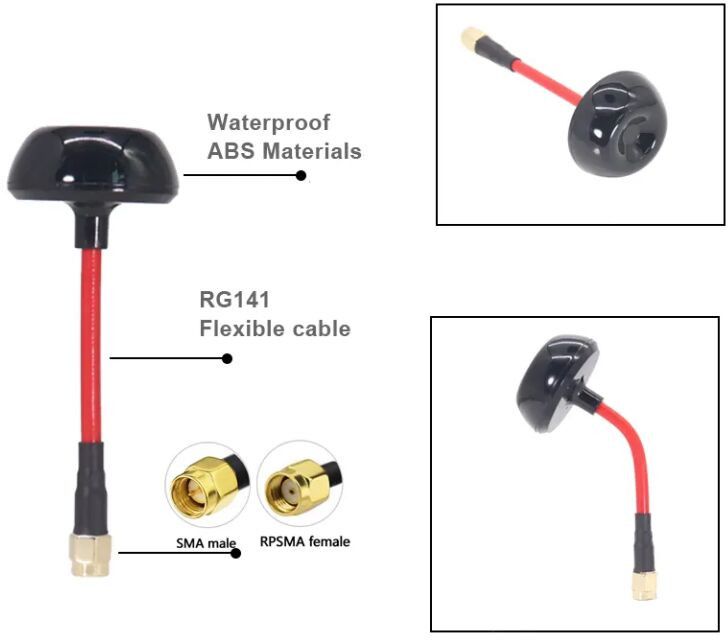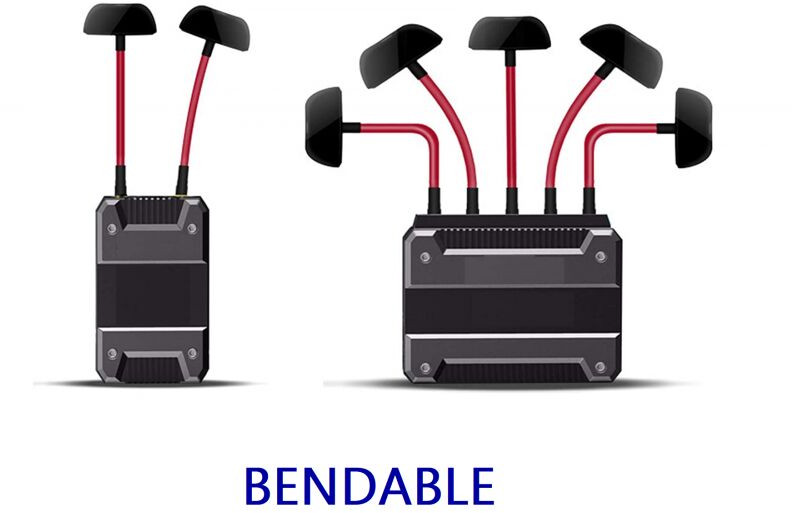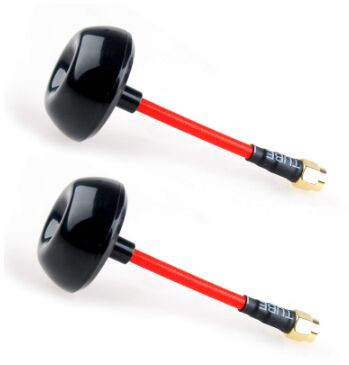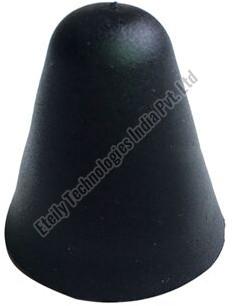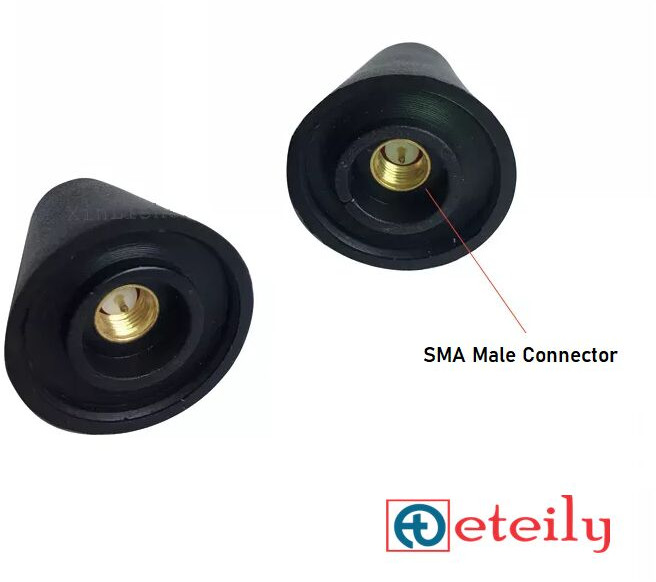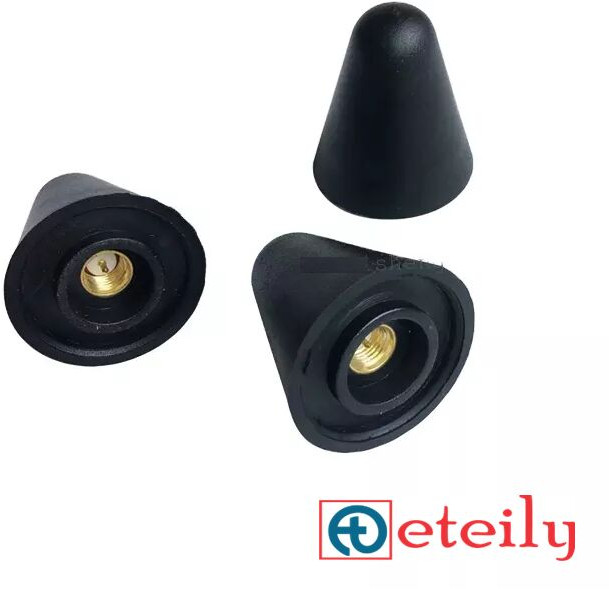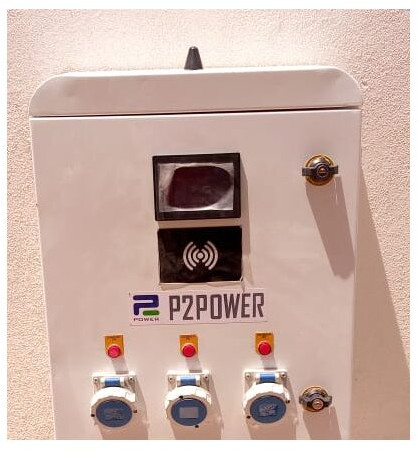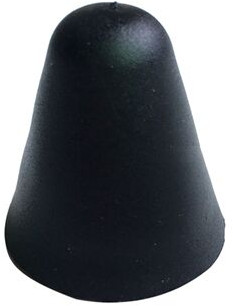- Vidya Nagar, Bhopal, Madhya Pradesh
- GST NO. : 23AADCL3954C1ZV
- +91-8889017888
WIFI Wlan Bluetooth Antenna
Leading Manufacturers, Exporters, Wholesaler, Trader and Distributor of 2.4GHz 24dBi Grid Parabolic Directional Antenna for Outdoor Applications, 2.4GHz 2dBi Internal PCB Antenna with 1.13mm (L-10CM) + UFL Connector, 2.4GHz 3dBi PCB Flexible Antenna with 1.13mm (L-10CM) Cable + UFL Connector, 2.4GHz 4dBi Ceiling Antenna with RG58 Cable (L - 3Mtr) + N (F) St. Connector, 2.4GHz 4dBi Wi-Fi Internal Mount Antenna with 1.13mm Cable (L-10cm) + UFL Connector, 2.4GHz/5.8GHz 10dBi Rubber Duck Paddle Antenna with SMA (M) Connector (Movable Body), 2.4GHz/5.8GHz 4dBi Internal PCB Antenna with 1.13mm (L-10CM) + UFL Connector, 5.8GHz 4-Leaf Clover Drone Antenna with RG178 (L-5CM) Cable + UFL Connector, 5.8GHz FPV Circular Polarized Drone Antenna with SMA (M) Connector and ET-WI3U-SMS Wi-Fi 3dBi Umbrella Antenna from Bhopal.
100 piece (MOQ)
Get Best Price| Business Type | Manufacturer, Exporter, Supplier, Trader, Distributor |
| Brand Name | ETEILY |
| Material | Stainless Steel |
| Color | Gray |
| Application | Industrial Use, Scienticfic Use |
| Feature | Fast Signal Stength, Hard Structure, High Acurace, Rust Proof, Waterproof |
| Type | Outdoor Antenna |
| Frequency | 2400~2500MHz |
| Product | Antenna |
| Mounting | Pole Mount |
| Dimension | Φ0.6X0.9m Mounting Mast Size: Φ40-70mm |
| Connector | N Female |
| Orientation | Straight |
| Product Code | ET-WI24GPA |
| Payment Terms | L/C, D/A, D/P, T/T, Western Union |
| Delivery Time | 5 Days |
Preferred Buyer From
| Location | Worldwide |
A 2.4GHz 24dBi grid parabolic directional antenna is a high-gain antenna designed to provide long-range, focused wireless signal transmission and reception. Here’s an in-depth look at this type of antenna:
Key Features:-
2.4GHz Frequency:
- Standard Band: Operates in the 2.4GHz frequency band, which is commonly used for Wi-Fi, some wireless communication devices, and various other applications.
-
24dBi Gain:
- High Gain: The 24dBi (decibel isotropic) gain indicates a high level of signal amplification. This high gain helps in focusing the signal over long distances, making it ideal for point-to-point communication or long-range Wi-Fi setups.
- Directional Focus: Provides a strong, narrow beam of signal, concentrating the energy in a specific direction to achieve extended range and improved signal quality.
-
Grid Parabolic Design:
- Parabolic Reflector: The parabolic shape helps to focus and direct the radio waves more effectively, enhancing signal strength and range.
- Grid Structure: The grid design minimizes wind resistance and weight while allowing effective signal transmission and reception. It also reduces the impact of rain and snow on performance.
-
Extended Range:
- Long-Distance Communication: Ideal for long-range applications where signals need to travel substantial distances, such as linking buildings, rural connectivity, or bridging networks.
-
Improved Signal Quality:
- Focused Beam: The high gain and directional nature of the antenna ensure that the signal is concentrated and travels further with less degradation, providing clearer and more stable connections.
-
Reduced Interference:
- Narrow Beamwidth: By focusing the signal in a specific direction, the antenna reduces the potential for interference from other signals and devices, improving overall performance.
-
Durability:
- Weather-Resistant Design: The grid parabolic structure is built to withstand various weather conditions, making it suitable for outdoor installations.
-
Directional Nature:
- Alignment: Since the antenna is directional, precise alignment is crucial to ensure it points directly at the target device or access point. Misalignment can lead to reduced performance or signal loss.
-
Installation:
- Mounting: The antenna needs to be securely mounted, typically on a pole or mast, to maintain its alignment and withstand environmental conditions.
- Height and Position: Install the antenna at an optimal height and position to maximize its line-of-sight with the target device.
-
Connector Type:
- Compatibility: Ensure the antenna has a compatible connector for your equipment, such as SMA, RP-SMA, or N-type connectors. Adapters may be needed if there is a mismatch.
-
Environmental Factors:
- Interference and Obstacles: Consider potential sources of interference and physical obstacles in the path of the signal. The effectiveness of the antenna can be affected by obstacles like buildings, trees, or other structures.
- Point-to-Point Links: Connecting two distant locations, such as between buildings or across a large property, where high gain and focused signal are required.
- Long-Range Wi-Fi: Extending the range of Wi-Fi networks in rural or expansive areas, providing connectivity over long distances.
- Outdoor Networks: Suitable for outdoor installations where high durability and resistance to environmental factors are necessary.
| Business Type | Manufacturer, Exporter, Supplier, Trader, Distributor |
| Brand Name | ETEILY |
| Material | Copper |
| Color | Golden |
| Condition | New |
| Application | Electrical Adaptor |
| Certification | CE Certified, ISI Certified |
| Type | Internal Antenna,Internal Antenna |
| Product | Antenna |
| Technology | WiFi |
| Radiation | Omnidirectional |
| Frequency | 2400~2500MHz |
| Gain | 2dBi |
| Connector | UFL Right Angled |
| Cable | 1.13mm |
| Product Code | ET-WI2PC-5L10CP4-U |
| Payment Terms | L/C, D/A, D/P, T/T, Western Union |
| Delivery Time | 5 Days |
Preferred Buyer From
| Location | Worldwide |
A 2.4GHz 2dBi internal PCB antenna is a specific type of antenna used in wireless communication, particularly for devices operating on the 2.4 GHz frequency band, which is common for Wi-Fi and other wireless technologies. Here's a detailed breakdown of its characteristics:
Key Features:-
2.4GHz Frequency:
- Purpose: This antenna is designed to operate at the 2.4 GHz frequency band, which is commonly used for Wi-Fi (802.11b/g/n), Bluetooth, and some other wireless communication standards.
- Band: It’s part of the ISM (Industrial, Scientific, and Medical) band that is unlicensed and widely used for various wireless applications.
-
2dBi Gain:
- Gain: The 2dBi indicates the antenna's gain, which measures how much power the antenna can focus in a particular direction compared to an isotropic radiator (a theoretical antenna that radiates equally in all directions). A 2dBi gain means that the antenna provides a modest increase in signal strength over an isotropic radiator.
- Performance: A 2dBi gain is relatively low, making this type of antenna suitable for shorter-range communication or scenarios where high gain is not critical. It typically provides good coverage for small to medium-sized areas, such as within a room.
-
Internal PCB:
- PCB (Printed Circuit Board) Antenna: This type of antenna is integrated directly into the circuit board of a device. It’s designed to be compact and cost-effective, and is often used in devices where space is limited or where external antennas are not practical.
- Design: PCB antennas are etched onto the surface of the PCB and are generally small, making them ideal for compact electronic devices.
-
Internal:
- Mounting: As an internal antenna, it’s embedded within the device rather than mounted externally. This helps maintain a compact design and avoids the need for external protrusions.
- Integration: Internal antennas are commonly used in devices like smartphones, tablets, routers, and other compact electronics where external antennas would be cumbersome or visually unappealing.
- Consumer Electronics: Used in devices such as smartphones, tablets, and laptops to provide Wi-Fi or Bluetooth connectivity.
- IoT Devices: Ideal for Internet of Things (IoT) devices where space is limited and external antennas are not feasible.
- Wireless Modules: Found in various wireless modules and embedded systems where an internal antenna solution is preferred for its compactness and ease of integration.
-
Benefits:
- Compact Design: Internal PCB antennas save space and are ideal for small devices.
- Cost-Effective: Integrating the antenna into the PCB reduces manufacturing costs and complexity.
- Aesthetic: Eliminates the need for external antennas, contributing to a cleaner device design.
-
Limitations:
- Limited Gain: With a 2dBi gain, the antenna provides lower signal strength compared to higher-gain antennas, which may limit its effective range and performance in challenging environments.
- Placement Sensitivity: Performance can be affected by the placement of the antenna within the device and the materials surrounding it.
100 piece (MOQ)
Get Best Price| Business Type | Manufacturer, Exporter, Supplier, Trader, Distributor |
| Brand Name | ETEILY,ETEILY |
| Material | Brass |
| Color | Golden |
| Condition | New |
| Application | Electrical Adaptor |
| Certification | CE Certified, ISI Certified |
| Type | Internal Antenna,Internal Antenna |
| Product | Antenna |
| Dimension | 22x18mm |
| Cable | 1.13mm |
| Connector | UFL Female Connector |
| Frequency | 2400~2500MHz |
| Gain | 3dBi |
| Product Code | ET-WI3FPC-5L10CP12-U |
| Payment Terms | L/C, D/A, D/P, T/T, Western Union |
| Delivery Time | 5 Days |
Preferred Buyer From
| Location | Worldwide |
A 2.4GHz 3dBi PCB flexible antenna combines elements of both PCB (Printed Circuit Board) and flexible antenna designs for specific wireless communication needs. Here’s a detailed look at its features and applications:
Key Features:-
2.4GHz Frequency:
- Frequency Band: This antenna is designed for the 2.4 GHz frequency band, commonly used for Wi-Fi (802.11b/g/n), Bluetooth, and some other wireless technologies. It operates within the ISM (Industrial, Scientific, and Medical) band.
-
3dBi Gain:
- Gain: A 3dBi gain indicates that the antenna provides a moderate increase in signal strength compared to an isotropic radiator. This gain level is higher than a 2dBi antenna, which can improve range and signal quality, but is still relatively modest compared to higher-gain antennas.
- Performance: The 3dBi gain is suitable for applications where moderate range and signal enhancement are needed. It is often used in environments where signal strength needs to be improved but extremely high gain is not required.
-
PCB (Printed Circuit Board):
- Design: The antenna is integrated into a PCB, which is a common method for creating compact and cost-effective antennas. The design allows for efficient manufacturing and integration into electronic devices.
- Integration: PCB antennas are etched onto the circuit board and are typically used in devices where space is at a premium, such as in compact electronic products.
-
Flexible:
- Flexibility: Unlike rigid PCB antennas, a flexible PCB antenna is made from materials that allow it to bend or conform to different shapes. This flexibility can be useful in devices where the antenna needs to be adapted to fit specific internal layouts or designs.
- Durability: Flexible PCBs are generally more durable and resistant to mechanical stress compared to rigid PCBs. They can be bent or adjusted without damaging the antenna, making them suitable for dynamic or confined spaces.
- Consumer Electronics: Used in devices such as smartphones, tablets, laptops, and other compact devices where internal space is limited and a flexible design is advantageous.
- IoT Devices: Ideal for Internet of Things (IoT) applications where the device may have a non-standard shape or requires a flexible antenna to fit into a small enclosure.
- Wearable Technology: Useful in wearable devices where the antenna needs to conform to the contours of the device or be embedded in flexible materials.
-
Benefits:
- Compact and Space-Efficient: Integrates directly into the PCB, saving space and reducing the need for additional components.
- Flexible Design: Allows the antenna to fit into various shapes and sizes, enhancing design versatility and adaptability.
- Moderate Gain: The 3dBi gain provides a balance between performance and range, suitable for many common wireless applications.
-
Limitations:
- Signal Range: While a 3dBi gain improves performance over lower-gain antennas, it may still be limited compared to antennas with higher gain, which are better for long-range communication.
- Placement Sensitivity: The performance of flexible PCB antennas can be influenced by their placement within the device and surrounding materials. Proper design and placement are crucial for optimal performance.
100 Meter (MOQ)
Get Best Price| Business Type | Manufacturer, Exporter, Supplier, Trader, Distributor |
| Brand Name | ETEILY |
| Material | PVC |
| Condition | New |
| Certification | ISO 9001:200 Certfied |
| Type | External Antenna |
| Product | Antenna |
| Mounting | Ceiling Mount |
| Cable | RG58 |
| Connector | N Female |
| Product Code | ET-WI4C-2L3-NFS |
| Payment Terms | L/C, D/A, D/P, T/T, Western Union |
| Delivery Time | 5 Days |
Preferred Buyer From
| Location | Worldwide |
A 2.4GHz 4dBi ceiling antenna is designed to enhance the wireless signal coverage for devices operating on the 2.4GHz frequency band, such as Wi-Fi routers, access points, and other wireless communication equipment. Here’s a comprehensive overview of this type of antenna:
Key Features:-
2.4GHz Frequency:
- Standard Wi-Fi Band: This frequency is commonly used for Wi-Fi communications, including 802.11b/g/n networks. It is also used by various other wireless devices.
-
4dBi Gain:
- Signal Strength: The 4dBi (decibel isotropic) gain indicates the antenna’s ability to boost the signal strength. The gain value reflects how well the antenna can direct and focus the signal compared to an isotropic radiator, which emits signal equally in all directions.
- Coverage: A 4dBi gain typically provides a good balance between coverage area and signal strength, suitable for medium-sized areas.
-
Ceiling Mounting:
- Placement: The ceiling-mount design allows the antenna to be installed on or near the ceiling, which can help in distributing the wireless signal more evenly throughout a room or area.
- Coverage Optimization: Ceiling-mounted antennas can help reduce signal obstructions caused by furniture or other objects, improving overall coverage and performance.
-
Enhanced Coverage:
- Improved Signal Distribution: Mounting the antenna on the ceiling can improve signal distribution across the area, reducing dead spots and improving connectivity for devices.
-
Reduced Interference:
- Better Placement: By placing the antenna on the ceiling, you can often avoid common sources of interference and physical obstructions that might be present at lower levels.
-
Aesthetics:
- Discreet Installation: Ceiling-mounted antennas can be less obtrusive and blend in with the room’s decor compared to wall-mounted or freestanding antennas.
-
Compatibility:
- Connector Type: Ensure that the antenna has a compatible connector for your device. Common connectors include SMA, RP-SMA, and others. If there’s a mismatch, you may need an adapter.
-
Installation:
- Mounting Requirements: Check the mounting requirements and make sure you have the necessary hardware and tools to securely attach the antenna to the ceiling.
- Orientation: Properly orient the antenna to maximize coverage and performance. Some antennas may have specific orientation requirements to achieve optimal gain.
-
Signal Propagation:
- Coverage Area: A 4dBi gain antenna typically offers a balance between coverage and signal strength. However, the actual coverage area can vary based on environmental factors and potential obstacles.
-
Aesthetic Impact:
- Appearance: Consider how the antenna will look in the space. Some ceiling-mounted antennas are designed to be discreet and blend in with the ceiling tiles or panels.
- Office Spaces: Enhancing wireless coverage in office environments to ensure consistent connectivity for employees and devices.
- Home Networks: Improving Wi-Fi signal distribution throughout a home, especially in areas with multiple rooms or levels.
- Retail and Public Spaces: Providing better wireless coverage in shops, cafes, and other public areas where reliable internet access is essential.
100 piece (MOQ)
Get Best Price| Business Type | Manufacturer, Exporter, Supplier, Trader, Distributor |
| Brand Name | ETEILY |
| Condition | New |
| Application | Electrical Adaptor |
| Certification | CE Certified, ISI Certified |
| Type | Internal Antenna |
| Product | Antenna |
| Technology | Wi-Fi |
| Radiation | Omnidirectional |
| Cable | RG178 |
| Connector | SMA Male |
| Product Code | ET-WI4SPA-5L10C-U |
| Payment Terms | L/C, D/A, D/P, T/T, Western Union |
| Delivery Time | 5 Days |
Preferred Buyer From
| Location | Worldwide |
A 4dBi Wi-Fi internal mount antenna is a specific type of antenna used in Wi-Fi networks. Here’s a detailed breakdown of its characteristics:
-
4dBi: This indicates the antenna's gain, measured in decibels relative to an isotropic radiator (dBi). A gain of 4dBi suggests that the antenna provides a moderate improvement in signal strength compared to an isotropic radiator. This level of gain is generally suitable for enhancing coverage within a reasonably sized area, like a home or office, but may not offer the long-range performance of higher-gain antennas.
-
Wi-Fi: This denotes that the antenna is designed specifically for use with Wi-Fi frequencies, typically in the 2.4 GHz and/or 5 GHz bands. Wi-Fi antennas are optimized to work with the standards used for wireless networking.
-
Internal Mount: This means the antenna is designed to be mounted inside a device or enclosure, such as inside a router or access point. Internal antennas are often used to maintain a sleek, compact design and to avoid external protrusions. They are usually integrated into the device itself, but some can be installed inside an enclosure or wall.
-
Antenna: In general, antennas are used to transmit or receive radio waves. For Wi-Fi, they facilitate wireless communication by sending and receiving signals between devices like routers, computers, and smartphones.
-
Coverage and Range: A 4dBi antenna will provide a balance between coverage and range. It’s more powerful than a basic internal antenna but doesn’t reach the extended range of higher-gain antennas. It’s suitable for typical home or office environments.
-
Design and Installation: Internal mount antennas are designed to fit within the device, which is useful for maintaining aesthetics and compactness. They’re often chosen for devices where external antennas would be impractical or undesirable.
-
Performance: The performance of an internal antenna also depends on the placement within the device and the surrounding materials. Internal antennas can be less efficient compared to external ones due to physical constraints and potential interference from the device’s enclosure.
-
Frequency Bands: Make sure the antenna supports the correct frequency bands for your Wi-Fi network. Most modern Wi-Fi antennas are designed to work with both 2.4 GHz and 5 GHz bands, but it's always good to confirm.
-
Routers and Access Points: Internal mount antennas are commonly used in routers and access points where a compact design is preferred.
-
Embedded Devices: They are also used in various embedded devices, such as IoT devices or wireless networking hardware, where space is at a premium.
Overall, a 4dBi internal mount Wi-Fi antenna is a practical choice for enhancing wireless network performance in devices where external antennas are not feasible.
100 Piece (MOQ)
Get Best Price| Business Type | Manufacturer, Exporter, Supplier, Trader, Distributor |
| Color | Black |
| Gain | 10 Db |
| Frequency | 2400~2500/5700~5800MHz |
| Type | External Antenna |
| Brand Name | ETEILY |
| Material | Rubber |
| Surface Finishing | Power Coated |
| Product | Antenna |
| Mounting | Connector Mount |
| Dimension | 195±2mm |
| Connector | SMA Male |
| Orientation | Movable |
| Product Code | ET-245810PRA-SMMO |
| Payment Terms | L/C, D/A, D/P, T/T, Western Union |
| Delivery Time | 5 Days |
Preferred Buyer From
| Location | Worldwide |
A 10dBi rubber duck paddle antenna is a type of antenna commonly used in radio communications. Here's a breakdown of what that means:
-
10dBi: The "dBi" stands for decibels relative to an isotropic radiator, which is a theoretical antenna that radiates power equally in all directions. A 10dBi gain means that the antenna is 10 decibels more effective at focusing energy in a particular direction than an isotropic antenna. Higher dBi values generally indicate a more directional antenna with increased range and performance.
-
Rubber Duck: The term "rubber duck" refers to a type of antenna that is often used in portable or handheld devices. These antennas are named for their shape, which can resemble a duck's head. They are typically flexible and have a simple, compact design.
-
Paddle: In this context, "paddle" usually means the antenna has a more rigid, paddle-like shape compared to the more flexible "rubber duck" antennas. The paddle design can offer better performance and durability, especially in fixed or semi-fixed installations.
-
Antenna: This is the component used to transmit or receive radio waves. It converts electrical signals into electromagnetic waves (and vice versa) and is a critical part of any radio communication system.
Combining these elements, a 10dBi rubber duck paddle antenna would be a high-gain, somewhat directional antenna with a design that balances the flexibility of a rubber duck with the rigidity of a paddle. It's suitable for applications where you need enhanced performance in a compact and durable package, like in certain fixed or portable radio setups.
If you’re considering using or purchasing one, make sure it matches your specific needs in terms of frequency range, mounting options, and intended application.
100 piece (MOQ)
Get Best Price| Business Type | Manufacturer, Exporter, Supplier, Trader, Distributor |
| Brand Name | ETEILY |
| Condition | New |
| Connection Type | Female |
| Application | Electrical Adaptor |
| Certification | CE Certified, ISI Certified |
| Type | Internal Antenna,Internal Antenna |
| Product | Antenna |
| Technology | Wi-Fi |
| Radiation | Omnidirectional |
| Mounting | PCB Mount |
| Dimension | 51x9mm |
| Cable | 1.13mm |
| Connector | UFL Female |
| Frequency | 2400~2500/5700~5800MHz |
| Product Code | ET-WI4PC-5L10CP15-U |
| Payment Terms | L/C, D/A, D/P, T/T, Western Union |
| Delivery Time | 5 Days |
Preferred Buyer From
| Location | Worldwide |
A 2.4GHz/5.8GHz 4dBi internal PCB antenna is designed to operate in both the 2.4 GHz and 5.8 GHz frequency bands, commonly used in Wi-Fi and other wireless communications. Here’s an in-depth look at its features and applications:
Key Features:-
2.4GHz/5.8GHz Frequency Bands:
- Dual-Band Capability: This antenna supports both 2.4 GHz and 5.8 GHz frequencies, which are standard for Wi-Fi (2.4 GHz is used by Wi-Fi 802.11b/g/n, and 5.8 GHz is used by Wi-Fi 802.11a/n/ac). This dual-band capability allows it to provide connectivity for a wide range of wireless applications.
- Flexibility: Operating on both bands ensures compatibility with various devices and reduces the need for multiple antennas.
-
4dBi Gain:
- Gain: The 4dBi gain rating indicates that the antenna provides a moderate increase in signal strength compared to an isotropic radiator. This level of gain enhances signal coverage and performance over the internal PCB antenna’s range.
- Performance: A 4dBi gain provides a good balance between coverage and performance, making it suitable for many indoor environments.
-
Internal PCB:
- Design: The antenna is integrated into the PCB (Printed Circuit Board) of the device. This integration is ideal for compact devices where space is limited.
- Cost-Effectiveness: PCB antennas are typically more cost-effective and simpler to manufacture than external antennas, making them a practical choice for many electronic devices.
- Consumer Electronics: Commonly used in devices like smartphones, tablets, laptops, and routers where internal space constraints make an external antenna impractical.
- IoT Devices: Ideal for Internet of Things (IoT) devices that require wireless communication and where space is at a premium.
- Wireless Modules: Found in various wireless modules and embedded systems where internal antennas offer a more compact and integrated solution.
-
Benefits:
- Dual-Band Operation: The ability to operate on both 2.4 GHz and 5.8 GHz bands provides flexibility and compatibility with a wide range of wireless standards and devices.
- Compact Design: The internal PCB design helps save space and integrates seamlessly into small devices.
- Moderate Gain: The 4dBi gain offers a good compromise between coverage and performance, suitable for most standard wireless applications.
-
Limitations:
- Range: While 4dBi gain improves performance over lower-gain antennas, it may still be limited compared to higher-gain antennas, especially in larger or more complex environments.
- Placement Sensitivity: The performance of internal antennas can be affected by their placement within the device and the surrounding materials. Proper design and placement are crucial for optimal performance.
100 piece (MOQ)
Get Best Price| Business Type | Manufacturer, Exporter, Supplier, Trader, Distributor |
| Brand Name | ETEILY |
| Material | Brass |
| Color | Golden |
| Condition | New |
| Application | Electronic Adaptor |
| Certification | CE Certified, ISI Certified |
| Type | External Antenna |
| Product | Antenna |
| Mounting | Connector Mount |
| Cable | RG178 |
| Connector | UFL Right Angled |
| Product Code | ET-584LCDA-3L5C-U |
| Payment Terms | L/C, D/A, D/P, T/T, Western Union |
| Delivery Time | 5 Days |
Preferred Buyer From
| Location | Worldwide |
A 5.8GHz 4-leaf clover drone antenna is a specialized antenna designed to enhance the performance of FPV (First-Person View) systems in drones. Here’s a detailed overview of what this type of antenna offers and its benefits:
Key Features:-
5.8GHz Frequency:
- Standard for FPV: The 5.8GHz frequency is commonly used for video transmission in FPV drone systems, providing a high-bandwidth connection for real-time video feeds.
-
4-Leaf Clover Design:
- Antenna Shape: The 4-leaf clover design refers to the antenna’s shape, which consists of four radiating elements arranged in a cloverleaf pattern. This design is known for its effectiveness in providing omnidirectional coverage and reducing interference.
- Polarization: Typically, this design offers circular polarization, which helps in minimizing signal loss due to reflections and multipath interference, providing a clearer video signal.
-
Omnidirectional Coverage:
- 360-Degree Reception: The cloverleaf design allows the antenna to receive signals from all directions, which is beneficial for maintaining a strong and consistent connection with the drone regardless of its orientation.
-
Enhanced Signal Quality:
- Reduced Interference: Circular polarization helps in reducing signal interference and maintaining a stable connection, which is crucial for high-quality FPV video streaming.
- Improved Range: The antenna's design can improve the range and reliability of the video transmission, reducing the likelihood of video dropouts or loss of signal.
-
Compatibility:
- Connector Type: Ensure that the antenna has a compatible connector for your FPV transmitter or receiver. Common connectors include SMA, RP-SMA, and others.
- Mounting: Verify that the antenna can be securely mounted on your drone or ground station.
-
Size and Weight:
- Drone Weight: The size and weight of the antenna should be suitable for your drone. Excessively large or heavy antennas might affect the drone’s flight performance.
-
Installation:
- Orientation: Install the antenna in a position where it can maintain a clear line of sight with the drone. Proper positioning can optimize signal reception and minimize potential obstructions.
-
Environmental Factors:
- Durability: Consider the antenna’s durability, especially if used in harsh environments or if the drone is subject to rough handling. Some antennas are designed to be more rugged and resistant to damage.
- FPV Racing: Enhancing video transmission quality and range in FPV racing drones.
- Aerial Photography: Improving video signal clarity for drones used in capturing high-quality aerial footage.
- Long-Distance Flights: Providing better signal stability for long-distance drone flights where maintaining a strong connection is critical.
- Improved Signal Quality: The 4-leaf clover design provides reliable and clear video transmission, crucial for FPV flying.
- Reduced Interference: Circular polarization helps in minimizing interference and maintaining signal integrity.
- Versatility: The omnidirectional nature of the antenna makes it suitable for various flight scenarios, providing consistent performance regardless of the drone’s orientation.
Overall, a 5.8GHz 4-leaf clover drone antenna is an effective choice for enhancing FPV video transmission, offering improved signal quality and range while maintaining a stable connection with your drone.
| Business Type | Manufacturer, Exporter, Supplier, Trader, Distributor |
| Brand | ETEILY |
| Color | Black |
| Condition | New |
| Application | Electronic Adaptor |
| Certification | CE Certified, ISI Certified |
| Type | External Antenna |
| Product | Antenna |
| Mounting | Connector Mount |
| Connector | SMA Male |
| Orientation | Straight |
| Product Code | ET-58FPVDA-SMS |
| Payment Terms | L/C, D/A, D/P, T/T, Western Union |
| Delivery Time | 5 Days |
Preferred Buyer From
| Location | Worldwide |
A 5.8GHz FPV circular polarized drone antenna is designed specifically for First-Person View (FPV) systems in drones, providing superior performance in video transmission and reception. Here’s a detailed look at this type of antenna and its features:
Key Features:-
5.8GHz Frequency:
- Common FPV Band: This frequency is widely used for FPV video transmission in drones, offering a balance between range and data bandwidth.
-
Circular Polarization:
- Signal Integrity: Circular polarization (both left-hand and right-hand circular polarization) helps in maintaining signal quality and reducing issues related to multipath interference and reflections.
- Improved Reception: It helps in minimizing signal dropouts and maintaining a clear video feed even when the drone or the transmitter is oriented in different directions.
-
Design Variants:
- Monopole Antennas: Simple design with a single radiating element, typically used for ground stations or drones.
- Dipole Antennas: Feature two elements and often offer better performance for certain applications.
- 4-Leaf Clover Design: A popular design for circular polarized antennas, providing robust omnidirectional coverage.
-
Omnidirectional Coverage:
- 360-Degree Signal Reception: The antenna provides signal reception from all directions, ensuring consistent performance as the drone changes orientation.
-
Enhanced Signal Quality:
- Reduced Interference: Circular polarization helps in reducing the effects of interference and signal degradation caused by reflections or obstacles.
- Clearer Video Feed: Provides a more stable and clear video feed, essential for FPV flying.
-
Increased Range:
- Longer Distance: Better signal reception and reduced interference can contribute to an extended range for FPV video transmission.
-
Versatility:
- Wide Application: Suitable for various FPV applications, including racing, aerial photography, and long-distance flights.
-
Connector Type:
- Compatibility: Ensure that the antenna connector matches the port on your FPV transmitter or receiver. Common connectors include SMA, RP-SMA, and others. Adapters may be needed if there is a mismatch.
-
Antenna Placement:
- Optimal Positioning: Position the antenna to maximize signal reception and minimize obstructions. For drones, ensure that the antenna is mounted securely and doesn’t interfere with flight dynamics.
-
Size and Weight:
- Drone Performance: The size and weight of the antenna should be suitable for your drone. Excessive weight or size might affect the drone’s flight performance and stability.
-
Durability:
- Build Quality: Choose an antenna that is durable and designed to withstand the rigors of drone flying, including potential impacts or rough handling.
-
Orientation Matching:
- Transmitter and Receiver: Ensure that the circular polarization (left-hand or right-hand) of the transmitter antenna matches that of the receiver antenna to achieve the best signal performance.
- FPV Racing: Ensuring high-quality video transmission for competitive drone racing.
- Aerial Photography: Providing clear and stable video feeds for capturing high-quality aerial images and video.
- Long-Distance FPV: Enhancing the reliability and clarity of the video feed during long-distance flights.
-
Mounting: For drones, mount the antenna in a position that allows for optimal signal reception and minimal obstruction. On ground stations, ensure that the antenna is positioned to cover the desired area effectively.
-
Alignment: For optimal performance, make sure the antenna is properly aligned and oriented according to the specific needs of your FPV setup.
| Business Type | Manufacturer, Exporter, Supplier, Trader, Distributor |
| Product | Antenna |
| Mounting | Connector Mount |
| Dimension | Dia: 28mm X H: 30mm |
| Connector | SMA Male |
| Type | External Antenna |
| Gain | 3dBi |
| Frequency | 2400~2500MHz |
| Color | Black |
| Product Code | ET-WI3U-SMS |
| Payment Terms | L/C, D/A, D/P, T/T, Western Union |
| Delivery Time | 5 Days |
Preferred Buyer From
| Location | Worldwide |
A 3dBi umbrella antenna is a specific type of antenna designed for wireless communication with a focus on providing a moderate level of gain and a broad radiation pattern. Here’s a detailed breakdown of its features and applications:
Key Features:-
3dBi Gain:
- Gain: The 3dBi rating indicates the antenna’s gain relative to an isotropic radiator. A 3dBi gain provides a moderate improvement in signal strength and is a step up from lower-gain antennas but not as high as those with more gain. It strikes a balance between coverage area and signal strength.
- Performance: This gain is suitable for a variety of applications where moderate performance is adequate. It’s often used in scenarios where high gain is not essential but improved signal quality is needed over a larger area.
-
Umbrella Design:
- Shape: The term “umbrella” refers to the antenna's shape, which is typically characterized by a round, or sometimes slightly conical, radiation pattern that resembles an open umbrella. This design helps to provide a relatively even signal distribution around the antenna.
- Radiation Pattern: Umbrella antennas are designed to radiate signals in a 360-degree horizontal pattern, making them effective for omnidirectional coverage. They are often used in situations where broad coverage is necessary.
-
Construction:
- Material: Umbrella antennas can be made from various materials, including metal or plastic, and might include elements like a metal rod or disc for the actual radiating element. The construction usually involves a base that connects to the device and a radiating element that extends outward.
- Mounting: These antennas can be mounted in various ways, including as external antennas on devices or as part of an integrated system.
- Wireless Networking: Used in Wi-Fi routers and access points to provide broad, omnidirectional coverage within a given area.
- Telecommunications: Suitable for general communication purposes where wide coverage is desired, such as in base stations or repeater systems.
- Consumer Electronics: Found in devices like wireless speakers, home automation systems, and other gadgets that benefit from a wide signal coverage pattern.
-
Benefits:
- Omnidirectional Coverage: The umbrella design provides even coverage in all horizontal directions, making it effective for general use where signal needs to be distributed evenly.
- Moderate Gain: The 3dBi gain provides a good balance between coverage area and signal strength, suitable for most indoor and some outdoor applications.
- Versatility: The umbrella antenna can be used in various scenarios where broad, uniform coverage is needed.
-
Limitations:
- Range: While 3dBi gain is moderate, it may not be sufficient for applications requiring extended range or higher performance. For long-range needs, antennas with higher gain might be more appropriate.
- Vertical Coverage: The umbrella antenna is typically optimized for horizontal coverage. Its vertical coverage might be less uniform compared to other types of antennas, which could affect performance in certain setups.

